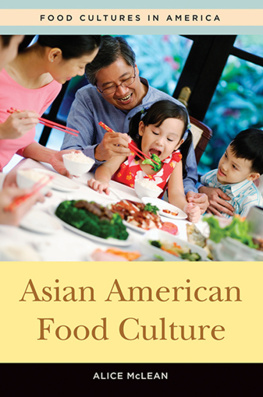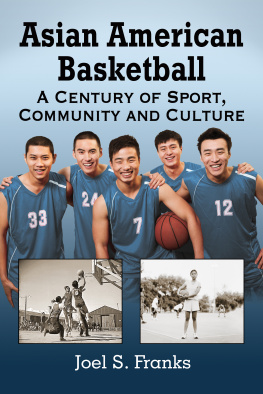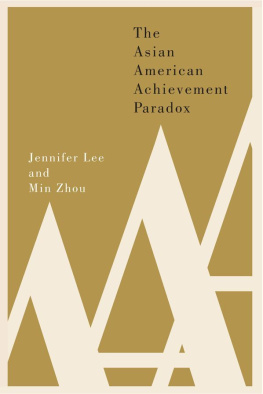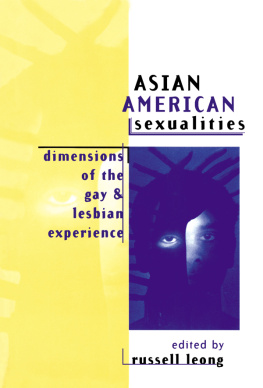McLean Alice L. - Asian American Food Culture
Here you can read online McLean Alice L. - Asian American Food Culture full text of the book (entire story) in english for free. Download pdf and epub, get meaning, cover and reviews about this ebook. City: Greenwood, year: 2013, publisher: ABC-CLIO, LLC;Greenwood, genre: Politics. Description of the work, (preface) as well as reviews are available. Best literature library LitArk.com created for fans of good reading and offers a wide selection of genres:
Romance novel
Science fiction
Adventure
Detective
Science
History
Home and family
Prose
Art
Politics
Computer
Non-fiction
Religion
Business
Children
Humor
Choose a favorite category and find really read worthwhile books. Enjoy immersion in the world of imagination, feel the emotions of the characters or learn something new for yourself, make an fascinating discovery.
- Book:Asian American Food Culture
- Author:
- Publisher:ABC-CLIO, LLC;Greenwood
- Genre:
- Year:2013
- City:Greenwood
- Rating:3 / 5
- Favourites:Add to favourites
- Your mark:
- 60
- 1
- 2
- 3
- 4
- 5
Asian American Food Culture: summary, description and annotation
We offer to read an annotation, description, summary or preface (depends on what the author of the book "Asian American Food Culture" wrote himself). If you haven't found the necessary information about the book — write in the comments, we will try to find it.
Asian American Food Culture — read online for free the complete book (whole text) full work
Below is the text of the book, divided by pages. System saving the place of the last page read, allows you to conveniently read the book "Asian American Food Culture" online for free, without having to search again every time where you left off. Put a bookmark, and you can go to the page where you finished reading at any time.
Font size:
Interval:
Bookmark:

Asian American Food Culture
Food Cultures in America
Ken Albala, General Editor
African American Food Culture
William Frank Mitchell
Asian American Food Culture
Alice L. McLean
Latino Food Culture
Zilkia Janer
Jewish American Food Culture
Jonathan Deutsch and Rachel D. Saks
Regional American Food Culture
Lucy M. Long
ALICE L. MCLEAN
Food Cultures in America
Ken Albala , General Editor

Copyright 2015 by ABC-CLIO, LLC
All rights reserved. No part of this publication may be reproduced, stored in a retrieval system, or transmitted, in any form or by any means, electronic, mechanical, photocopying, recording, or otherwise, except for the inclusion of brief quotations in a review, without prior permission in writing from the publisher.
Library of Congress Cataloging-in-Publication Data
McLean, Alice L.
Asian American food culture / Alice L. McLean.
pages cm (food cultures in America)
Includes bibliographical references and index.
ISBN 978-0-313-34144-1 (hardback) ISBN 978-1-56720-690-6
1. Food habitsSocial aspectsUnited States. 2. FoodSocial aspects United States. 3. Cooking, AsianSocial aspects. 4. Asian Americans Ethnic identity. 5. Asian AmericansSocial life and customs. I. Title.
GT2853.U5M395 2015
394.1'20973dc23 2014047824
ISBN: 978-0-313-34144-1
EISBN: 978-1-56720-690-6
19 18 17 16 15 1 2 3 4 5
This book is also available on the World Wide Web as an eBook.
Visit www.abc-clio.com for details.
Greenwood
An Imprint of ABC-CLIO, LLC
ABC-CLIO, LLC
130 Cremona Drive, P.O. Box 1911
Santa Barbara, California 93116-1911
This book is printed on acid-free paper 
Manufactured in the United States of America
The publisher has done its best to make sure the instructions and/or recipes in this book are correct. However, users should apply judgment and experience when preparing recipes, especially parents and teachers working with young people. The publisher accepts no responsibility for the outcome of any recipe included in this volume.
For my father who taught me the pleasures of eating, instilled in me a passion for cooking, and urged me to be ever curiouser and curiouser.
And for Kella, whose love of culinary adventure and hunger for all things edible have proven invaluable sustenance, and for her Auntie Josie, who has nourished me with dish after delectable dish of Filipino savories.
If you think of iconic and quintessentially American foods, those with which we are most familiar, there are scarcely any truly native to North America. Our hot dogs are an adaptation of sausages from Frankfurt and Vienna; our hamburgers are another Germanic import reconfigured. Ketchup is an invention of Southeast Asia, although it is based on the tomato, which comes from South America. Pizza is a variant on a Neapolitan dish. Colas are derived from an African nut. Our beloved peanuts are a South American plant brought to Africa and from there to the U.S. South. Our french fries are an Andean tuber, cooked with a European technique. Even our quintessentially American apple pie is made from a fruit native to what is today Kazakhstan.
When I poll my students about their favorite foo ds at the start of every food class I teach, inevitably included are tacos, bagels, sushi, pasta, fried chickenmost of which can be found easily at fast-food outlets a few blocks from campus. In a word, American food culture is, and always has been, profoundly globally oriented. This, of course, has been the direct result of immigration, from the time of earliest settlement by Spanish, English, French, and Dutch to slaves brought by force from Africa, to later arrival by Germans, Italians, Eastern Europeans (including Jews), and Asians, and up until now with the newest immigrants from Latin America and elsewhere.
Although Americans have willingly adopted the foods of newcomers, we never became a melting pot for these various cultures. So-called ethnic cuisines naturally changed on foreign soil, adapting to new ingredients and popular tastebut at heart they remain clear and proud descendants of their respective countries. Their origins are also readily recognized by Americans; we are all perfectly familiar with the repertoire of Mexican, Chinese, and Italian restaurants, and increasingly now Thai, Japanese, and Salvadoran, to name a few. Eating out at such restaurants is a hallmark of mainstream American culture, and despite the spontaneous or contrived fusion of culinary styles, each retains its unique identity.
This series is designed as an introduction to the major food cultures of the United StatesJewish American, Hispanic, Asian American, African American, and regional. Each volume delves deeply into the history and development of a distinct ethnic or regional cuisine. The volumes further explore these cuisines through their major ingredients, who is cooking and how at home, the structure of mealtime and daily rituals surrounding food, and the typical meals and how they are served, which can be dramatically different from popular versions. In addition, chapters cover eating out, holidays, and special occasions, as well as the influence of religion, and the effect of the diet on health and nutrition. Recipes are also included. Each volume offers valuable features, including a timeline, glossary, and index, making each a convenient reference work for research.
This series is important for our understanding of ourselves on several levels. Food is central to how we define ourselves, so in a sense this series not only recounts how recipes and foodways serve as distinct reminders of ethnic identity, binding families and communities together through shared experiences but it also describes who we have all become, as each food culture has become an indispensable part of our collective identity as Americans.
Ken Albala
University of the Pacific
Since the mid-19th century Asian immigrants to the United States have brought their influences to bear on American culture, yielding a rich, varied, and nuanced culinary landscape. Asians not only introduced their culinary traditions to the United States but also played an invaluable role in pioneering the U.S. food system. Just a few of their monumental contributions include helping to establish the Gulf Coast shrimping and rice industries and working alongside Mexicans to develop California into a global agricultural powerhouse. Asian Americans likewise fought resolutely for labor rights, playing a foundational role in the movement for just treatment of food workers in the United States.
Despite their considerable contributions to the 19th-and early 20th-century U.S. economy, Asians were barred from immigrating to the United States by a series of laws beginning with the Chinese Exclusion Act of 1883 and culminating with the National Origins Act in 1924, which banned Asian entry into the United States. Although exceptions would be made to the law, Asian immigration would not regain substantial momentum until the Immigration Act repealed national origin quotas in 1965. Since the repeal, over 18 million Asians have immigrated to the United States. These numbers have been bolstered by the United States involvement in both the Korean and Vietnam Wars as well as by the rise of globalization.
Font size:
Interval:
Bookmark:
Similar books «Asian American Food Culture»
Look at similar books to Asian American Food Culture. We have selected literature similar in name and meaning in the hope of providing readers with more options to find new, interesting, not yet read works.
Discussion, reviews of the book Asian American Food Culture and just readers' own opinions. Leave your comments, write what you think about the work, its meaning or the main characters. Specify what exactly you liked and what you didn't like, and why you think so.










